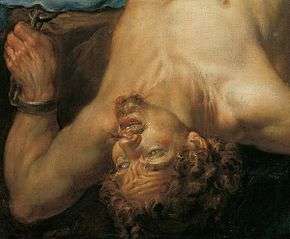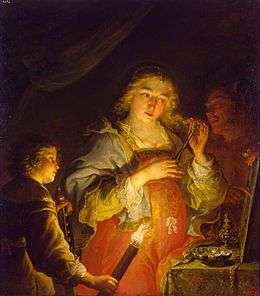Jacques de l'Ange

Jacques de l'Ange or the Monogrammist JAD (fl. 1630 – 1650) was a Flemish painter and draughtsman known for his genre scenes and history paintings executed in a Caravaggesque style. The artist was only rediscovered in the mid-1990s as his work was previously attributed to other Northern Caravaggists and in particular those of the Utrecht School.[1]
Life

Very little is known about the life of Jacques de l'Ange. It is not clear whether he should be identified with the genre and history painter Jacques (Jacob) de Langhe who was active in Antwerp in 1632–1633 and was a pupil of Jan Cossiers.[2] Jacques de l'Ange is known to have trained under Jan Cossiers.[1]
He became a master in Antwerp's Guild of Saint Luke in 1632-1633. He was active in Antwerp around 1630 to 1640.[1]
Work
Rediscovery
Jacques de l'Ange was only rediscovered in 1994 by the scholar Bernhard Schnackenburg when he was able to link the painting of the Holy Family in the Noordbrabants Museum in 's-Hertogenbosch signed with the monogram JAD to a number of other Caravaggesque paintings.[3] Previously Jacques de l'Ange was only known as the ‘Monogrammist JAD’ because he signed his paintings with just these initials.[4]
Prior to his rediscovery de l’Ange’s compositions had been attributed to other painters principally from the Utrecht School, such as Gerard van Honthorst, Joachim Sandrart and Matthias Stom.[5] The confusion with these other painters was likely caused by the fact that like them Jacques de l'Ange painted in a style influenced by Caravaggio. De l’Ange’s master Jan Cossiers also started out as a follower of Caravaggio whose work Cossiers may have studied during a stay in Rome.[6]

History painting
The compositions currently ascribed to de l’Ange include religious and mythological subjects as well as allegorical genre scenes. Examples of the former include the Chained Prometheus (Lempertz, 19 May 2007, Cologne, lot 1085) and The Holy Family (Noordbrabants Museum, 's-Hertogenbosch). The latter composition has also been ascribed previously to Abraham van Diepenbeeck and Pieter van Lint.[7]
Seven deadly sins
Jacques de l'Ange is mainly known for his series of seven genre paintings depicting the Seven deadly sins. He executed various copies of the series attesting to the popularity of the subject at the time.[4] They are kept, amongst others, in the Hermitage Museum, the Milwaukee Art Museum, the Museumslandschaft Hessen Kassel and the Musée du Séminaire (Quebec). On its website, the Hermitage still attributes the Allegory of Vanity to Joachim Sandrart.[8] Another painting in the series of deadly sins depicting 'Lust' has been identified in the collection of the Reggio Emilia, Galleria Parmiggiani, where it had been attributed to Joachim Sandrart and Matthias Stom.[9][10]
The Ashmolean Museum has a complete set of the seven compositions executed on copper. These are believed to have been painted by Jacques de l'Ange as small-scale ricordi after completion of the series around 1642.[5]
.jpg)
Like other followers of Caravaggio, de l’Ange used light, usually from a single source, to create dramatic effect. For instance in his composition representing Gluttony he placed a candle on the right-hand side of the composition to create dramatic, almost theater-like shadows. As a result, the scene emerges from the dark background and gains depth as the modelling of the figures is accentuated.[4]
Further reading
- Bernhard Schnackenburg, 'Der Monogrammist JAD (Jacques de l'Ange?), ein neuendeckter flämischer Maler aus den Jahren um 1640', Wallraf-Richartz-Jahrbuch 55 (1994), p. 205-226
- Bernhard Schnackenburg, 'Jacques de l'Ange. Ein flämischer Maler zwischen Jan Cossiers und Matthias Stom. Zum Nachtstück in Antwerpen und Neapel um 1640. Mit einem Werkverzeichnis', Wallraf-Richartz-Jahrbuch 66 (2005), p. 109-138
References
- 1 2 3 Monogrammist JAD at the Netherlands Institute for Art History (Dutch)
- ↑ Jacques de Langhe at the Netherlands Institute for Art History (Dutch)
- ↑ Bernhard Schnackenburg, Der Monogrammist JAD (Jacques de l'Ange?). Ein neuentdeckter Flämischer Maler aus den Jahren um 1640, in Frank Günter Zehnder (ed.), Wallraf-Richartz-Jahrbuch, Köln, 1994, pp 205-226
- 1 2 3 Catherine Sawinski, From the Collection–Jacques de l’Ange’s ‘Gluttony’, Posted on 20 February 2012 at the Milwaukee Art Museum site
- 1 2 Jacques de L'Ange, Der Geiz at Lempertz
- ↑ Nicholas Turner, European Drawings 4: Catalogue of the Collections, Getty Publications, 2001, p. 123
- ↑ Monogrammist JAD, De H. Familie, ca. 1640 's-Hertogenbosch, Noordbrabants Museum at the Netherlands Institute for Art History (Dutch)
- ↑ Sandrart, Joachim von, I. 1606-1688, 'Allegory of Vanity' at the Hermitage website, consulted on 16 January 2016
- ↑ "Der Geiz". Alte Frau beim Goldwiegen at the website of Museumslandschaft Hessen Kassel, consulted on 16 January 2016 (German)
- ↑ Allegoria: la Lussuria (gli amanti) at the website of the Comune di Reggio Emilia, consulted on 16 January 2016 (Italian)
External links
 Media related to Jacques de l'Ange at Wikimedia Commons
Media related to Jacques de l'Ange at Wikimedia Commons